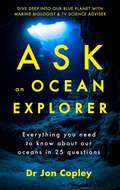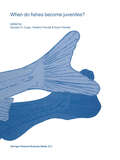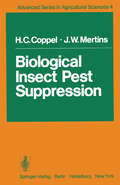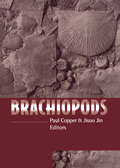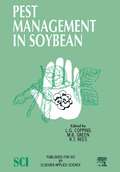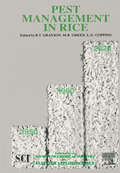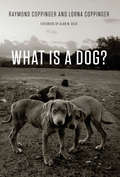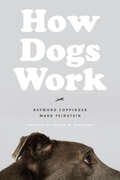- Table View
- List View
The Dawn of Modern Cosmology: From Copernicus to Newton
by Nicolaus Copernicus Galileo Galilei Johannes Kepler René Descartes Isaac NewtonNew to Penguin Classics, the astonishing story of the Copernican Revolution, told through the words of the ground-breaking scientists who brought it aboutIn the late fifteenth century, it was believed that the earth stood motionless at the centre of a small, ordered cosmos. Just over two centuries later, everything had changed. Not only was the sun the centre of creation, but the entire practice of science had been revolutionised. This is the story of that astonishing transformation, told through the words of the astronomers and mathematicians at its heart. Bringing together excerpts from the works and letters of Copernicus, Galileo, Kepler, Descartes, Newton and others for the first time, The Dawn of Modern Cosmology is the definitive record of one of the great turning points in human history.Edited with Translations, Notes and an Introduction by Aviva Rothman
Ask an Ocean Explorer
by Dr Jonathan Copley'Deftly conjures the wonders of a bathynaut's world' - Nature'An engaging book sprinkled with mind-blowing facts about the deep ocean' - Daily ExpressIt is often said that we know more about space than we do our own oceans, but is that really the case? Or do we in fact know a great deal more about the oceans than many people realise.The wellbeing of our oceans and the life contained within and around them has never been more important. But to truly understand the vital role they play, we need to first understand how the oceans work, how we explore them and learn about the mysteries they hold, and what our effect is on them.Between these pages is everything you need to know about our oceans, explained in 25 questions. Combining untold history of ocean exploration and personal account of what it's like to be a 'bathynaut' diving in a mini-submarine, Ask an Ocean Explorer brings to light weird and wonderful deep-sea creatures and how the oceans and their future is connected to our everyday lives.
When do fishes become juveniles? (Developments in Environmental Biology of Fishes #19)
by G. H. Copp Vladimír Kovác K. HenselMetamorphosis and the transition from larvae or embryos to juveniles in fishes are important in order to answer, for example, questions about: (1) life-history styles and their modifications in evolutionary perspective and within current environmental demands; (2) the development and application of fisheries recruitment models, (3) the use of ontogenetic scales for interspecific comparisons, (4) the identification of ontogenetic shifts in resource use, and (5) the discovery of evolutionary interrelationships of species or genera. This volume is dedicated to recent studies and reviews of existing knowledge on this insufficiently-addressed area of ichthyology. Most of the papers in this volume were presented in Bratislava, Slovakia, at the 1st International Workshop of the Fish Ontogeny Network of Europe (FONE) in September 1997, a meeting sponsored in part by the European Commission. This volume emphasizes an integrated approach to the study of fish ontogeny, which is a process during which one event is related to another and everything is related to everything else, encompassing physiology, morphology, behaviour and niche. Within this comprehensive perspective, the papers in this volume are grouped along four major themes: reflections on early ontogeny and metamorphosis, organism-environment relationships, ontogeny of predator-prey interactions, and behaviour and ontogeny. Among other issues, the papers consider topics such as whether one can identify when fish metamorphosis ends, whether the larva period begins with hatching or with the onset of exogenous feeding, whether fish ontogeny is `saltatory' or `gradual', and whether larvae are eliminated in some fishes with direct development. The keynote paper of this volume reviews the main topics within contemporary paradigms and the final paper concludes that the onset of the juvenile period can be identified in some species, but precision remains problematic, emphasizing the need for further research in this dynamic area of fish biology.
Biological Insect Pest Suppression (Advanced Series in Agricultural Sciences #4)
by H. C. Coppel J. W. MertinsThe subject area embraced by the term "biological control" in its classical sense is very broad indeed. The term itself was apparently first used in 1919 by the late Harry S. Smith, and was then used specifically in reference to the suppression of insect populations by the actions of their indigenous or introduced natural enemies. The California school of biological control specialists who followed in Smith's footsteps have traditionally differentiated "natural" biological control (by indigenous natural enemies) and "applied" biological control (by man-introduced natural enemies). Subsequently, the philosophy broadened beyond the original narrow concern with population suppression of insects (and especially pest insects), to embrace directed activities against mites or other arthropod pests, various invertebrate and vertebrate pests, weeds, and organisms producing disease in humans or their domestic animals and plants. The techniques used in these activities also multiplied beyond the original concern with natural enemies. The subjects area discussed in this book is, at the same time, broader and more restricted than that covered in other books on "biological control. " On the one hand, the treatment here is restrictive in that, with rare exception, we have limited ourselves to dealing only with ideas and examples involving the suppression of insect pests through human activity or intervention in the environment.
X-Ray Charge Densities and Chemical Bonding (International Union of Crystallography Texts on Crystallography)
by Philip CoppensThis book deals with the electron density distribution in molecules and solids as obtained experimentally by X-ray diffraction. It is a comprehensive treatment of the methods involved, and the interpretation of the experimental results in terms of chemical bonding and intermolecular interactions. Inorganic and organic solids, as well as metals, are covered in the chapters dealing with specific systems. As a whole, this monograph is especially appealing because of its broad interface with numerous disciplines. Accurate X-ray diffraction intensities contain fundamental information on the charge distribution in crystals, which can be compared directly with theoretical results, and used to derive other physical properties, such as electrostatic moments, the electrostatic potential and lattice energies, which are accessible by spectroscopic and thermodynamic measurements. Consequently, the work will be of great interest to a broad range of crystallographers and physical scientists.
Electron Distributions and the Chemical Bond
by Philip Coppens Michael B. HallThis book represents the proceedings of a symposium held at the Spring 1981 ACS meeting in Atlanta. The symposium brought together Theoretical Chemists, Solid State Physicists, Experimen tal Chemists and Crystallographers. One of its major aims was to increase interaction between these diverse groups which often use very different languages to describe similar concepts. The devel opment of a common language, or at least the acquisition of a multilingual capability, is a necessity if the field is to prosper. Much depends in this field on the interplay between theory and experiment. Accordingly this volume begins with two introduc tory chapters, one theoretical and the other experimental, which contain much of the background material needed for a through under standing of the field. The remaining sections describe a wide variety of applications and illustrate, we believe, the central role of charge densities in the understanding of chemical bonding. We are most indebted to the Divisions of Inorganic and Phy sical Chemistry of the American Chemical Society, which provided the stimulus for the symposium and gave generous financial support. We also gratefully acknowledge financial support from the Special Educational Opportunities Program of the Petroleum Research Fund administered by the American Chemical Society, which made exten sive participation by speakers from abroad possible.
Brachiopods
by Paul CopperThis collection of conference papers presents information on the molecular genetics, biomineralization, growth and ecology of extant brachiopod stocks (extrapolated back to the Cambrian), and the shell microstructure, taphonomy, paleogeography, evolution, and taxonomy of fossil brachiopods.
Brachiopods: The O/s Extinction Recovery Fauna (Special Papers In Palaeontology Ser. #No. 74)
by Paul CopperThis collection of conference papers presents information on the molecular genetics, biomineralization, growth and ecology of extant brachiopod stocks (extrapolated back to the Cambrian), and the shell microstructure, taphonomy, paleogeography, evolution, and taxonomy of fossil brachiopods.
Wilms Tumor: Clinical and Molecular Characterization (Molecular Biology Intelligence Unit)
by Max J. Coppes Christine E. Campbell Bryan WilliamsWT1 is a DNA Binding Protein Containing Four C2H2 Zinc Fingers . . . . . . . . . . . . . . . . . . . . . . . . . . . . . . . . . . . . . . . . . . . . . . 89 The DNA Binding Domain ofWT1 ··············································~··· 90 WT1 Inhibits Tag and SV40 Origin Dependent Replication . . . . . . . . . . . . . . . . . . . . . . . . . . . . . . . . . . . . . . . . . . . . . . . . . . . . . . . . . 97 WT1 is an Unusual C2H2 Zinc Finger Protein . . . . . . . . . . . . . . . . . . . . . . . . . . . . . . . . . . 98 WT1 is a Transcriptional Regulator . . . . . . . . . . . . . . . . . . . . . . . . . . . . . . . . . . . . . . . . . . . . . . . . . . . . 99 Possible Downstream Targets ofWT1 Transcriptional Regulation . . . 103 Protein-Protein Interactions Involving WT1 . . . . . . . . . . . . . . . . . . . . . . . . . . . . . . . . . . . . . 104 Other Factors that May Contribute to or Modify the Cellular Function ofWT1 . . . . . . . . . . . . . . . . . . . . . . . . . . . . . . . . . . 104 WT1 and Apoptosis . . . . . . . . . . . . . . . . . . . . . . . . . . . . . . . . . . . . . . . . . . . . . . . . . . . . . . . . . . . . . . . . . . . . . . . . . . 106 Conclusion . . . . . . . . . . . . . . . . . . . . . . . . . . . . . . . . . . . . . . . . . . . . . . . . . . . . . . . . . . . . . . . . . . . . . . . . . . . . . . . . . . . . . . . . 107 7. Naturally Occurring Mutations in the WTJ Gene . . . . . . . . . . . . . . . . . . 113 Introduction . . . . . . . . . . . . . . . . . . . . . . . . . . . . . . . . . . . . . . . . . . . . . . . . . . . . . . . . . . . . . . . . . . . . . . . . . . . . . . . . . . . . . 113 WTI Mutations in Wilms Tumor . . . . . . . . . . . . . . . . . . . . . . . . . . . . . . . . . . . . . . . . . . . . . . . . . . . . . 114 Analysis of WTI Mutations in Tumors Other than Wilms Tumor . . . 122 Constitutional WTI Mutations and the Denys-Drash Syndrome . . . . . . 125 Conclusion . . . . . . . . . . . . . . . . . . . . . . . . . . . . . . . . . . . . . . . . . . . . . . . . . . . . . . . . . . . . . . . . . . . . . . . . . . . . . . . . . . . . . . . . 131 8. Other Loci Implicated in Wtlms Tumor . . . . . . . . . . . . . . . . . . . . . . . . . . . . . . . . . 137 Introduction . . . . . . . . . . . . . . . . . . . . . . . . . . . . . . . . . . . . . . . . . . . . . . . . . . . . . . . . . . . . . . . . . . . . . . . . . . . . . . . . . . . . . 137 Nephrogenic Rests, WTI Mutations and Wilms Tumor . . . . . . . . . . . . . . . . . . . 137 Undetectable WTI Mutations . . . . . . . . . . . . . . . . . . . . . . . . . . . . . . . . . . . . . . . . . . . . . . . . . . . . . . . . . . . 138 Wilms Tumor and WITI . . . . . . . . . . . . . . . . . . . . . . . . . . . . . . . . . . . . . . . . . . . . . . . . . . . . . . . . . . . . . . . . . . 140 Loss of Heterozygosity for Chromosome 1 p and 16q . . . . . . . . . . . . . . . . . . . . . . . . 141 Wilms Tumor and Beckwith-Wiedemann Syndrome . . . . . . . . . . . . . . . . . . . . . . . . 141 Wilms Tumor and Perlman Syndrome . . . . . . . . . . . . . . . . . . . . . . . . . . . . . . . . . . . . . . . . . . . . . 144 Imprinting, IGF/l, HI9 and Wilms Tumor . . . . . . . . . . . . . . . . . . . . . . . . . . . . . . . . . . . . . . 144 Wilms Tumor and Li-F raumeni Syndrome . . . . . . . . . . . . . . . . . . . . . . . . . . . . . . . . . . . . . . . 149 Familial Wilms Tumor . . . . . . . . . . . . . . . . . . . . . . . . . . . . . . . . . . . . . . . . . . . . . . . . . . . . . . . . . . . . . . . . . . . . . 149 Wilms Tumor and Other Disease Associations . . . . . . . . . . . . . . . . . . . . . . . . . . . . . . . . . 150 Conclusion . . . . . . . . . . . . . . . . . . . . . . . . . . . . . . . . . . . . . . . . . . . . . . . . . . . . . . . . . . . . . . . . . . . . . . . . . . . . . . . . . . . . . . . . 150 Index . . . . . . . . . . . . . . . . . . . . . . . . . . . . . . . . . . . . . . . . . . . . . . . . . . . . . . . . . . . . . . . . . . . . . . . . . . . . . . . . . . . . . . . . . . . . . . 15 7 =====PREFACE===== ilms tumor is a common pediatric neo
Pest Management in Soybean
by L. G. Copping M. B. Green R. T. ReesThis book is the third in a series of volumes on major tropical and sub-tropical crops. These books aim to review the current state of the art in management of the total spectrum of pests and diseases which affect these crops in each major growing area using a multi-disciplinary approach. Soybean is economically the most important legume in the world. It is nutritious and easily digested, and is one of the richest and cheapest sources of protein. It is currently vital for the sustenance of many people and it will play an integral role in any future attempts to relieve world hunger. Soybean seed contains about 17% of oil and about 63% of meal, half of which is protein. Modern research has developed a variety of uses for soybean oil. It is processed into margarine, shortening, mayonnaise, salad creams and vegetarian cheeses. Industrially it is used in resins, plastics, paints, adhesives, fertilisers, sizing for cloth, linoleum backing, fire extinguishing materials, printing inks and a variety of other products. Soybean meal is a high-protein meat substitute and is used in the developed countries in many processed foods, including baby foods, but mainly as a feed for livestock. Soybean (Glycine max), which evolved from Glycine ussuriensis, a wild legume native to northern China, has been known and used in China since the eleventh century Be. It was introduced into Europe in the eighteenth century and into the United States in 1804 as an ornamental garden plant in Philadelphia.
Pest Management in Rice
by L.G. CoppingThe four-day international Conference on Pest Management in Rice, which is the subject of this volume, was the third in an ongoing series of meetings on tropical crops organised by the Pesticides Group of the Society of Chemical Industry, London. The participants came from both the public and private sectors and from many different countries. All the major groups of pests-weeds, microorganisms, arthropods and rodents-were considered, as the organisers believe that it is necessary to address the total pest management problems in each particular growing area, and the variety of the papers indicates the importance of a multi disciplinary approach to their solution. Rice is one of the most important world crops and is the major source of food for around 60% of the world's population, with a world production of 500 million tonnes from 150 million hectares of land. Since world stocks amount to only two months supply, many people are at risk from famine. Moreover, it has been esti mated that the world requirement in 2020 will be about 760 million tonnes, an increase of 50%. This pressure of population on food makes efficient pest management vital and is the reason for bringing together experts from all over the world to this major conference.
What Is a Dog?: Observations From The Wild
by Raymond Coppinger Lorna CoppingerOf the world’s dogs, less than two hundred million are pets, living with humans who provide food, shelter, squeaky toys, and fashionable sweaters. But roaming the planet are four times as many dogs who are their own masters—neighborhood dogs, dump dogs, mountain dogs. They are dogs, not companions, and these dogs, like pigeons or squirrels, are highly adapted scavengers who have evolved to fit particular niches in the vicinity of humans. In What Is a Dog? experts on dog behavior Raymond and Lorna Coppinger present an eye-opening analysis of the evolution and adaptations of these unleashed dogs and what they can reveal about the species as a whole. Exploring the natural history of these animals, the Coppingers explain how the village dogs of Vietnam, India, Africa, and Mexico are strikingly similar. These feral dogs, argue the Coppingers, are in fact the truly archetypal dogs, nearly uniform in size and shape and incredibly self-sufficient. Drawing on nearly five decades of research, they show how dogs actually domesticated themselves in order to become such efficient scavengers of human refuse. The Coppingers also examine the behavioral characteristics that enable dogs to live successfully and to reproduce, unconstrained by humans, in environments that we ordinarily do not think of as dog friendly. Providing a fascinating exploration of what it actually means—genetically and behaviorally—to be a dog, What Is a Dog? will undoubtedly change the way any beagle or bulldog owner will reflect on their four-legged friend.
What Is a Dog?: Observations From The Wild
by Raymond Coppinger Lorna CoppingerOf the world’s dogs, less than two hundred million are pets, living with humans who provide food, shelter, squeaky toys, and fashionable sweaters. But roaming the planet are four times as many dogs who are their own masters—neighborhood dogs, dump dogs, mountain dogs. They are dogs, not companions, and these dogs, like pigeons or squirrels, are highly adapted scavengers who have evolved to fit particular niches in the vicinity of humans. In What Is a Dog? experts on dog behavior Raymond and Lorna Coppinger present an eye-opening analysis of the evolution and adaptations of these unleashed dogs and what they can reveal about the species as a whole. Exploring the natural history of these animals, the Coppingers explain how the village dogs of Vietnam, India, Africa, and Mexico are strikingly similar. These feral dogs, argue the Coppingers, are in fact the truly archetypal dogs, nearly uniform in size and shape and incredibly self-sufficient. Drawing on nearly five decades of research, they show how dogs actually domesticated themselves in order to become such efficient scavengers of human refuse. The Coppingers also examine the behavioral characteristics that enable dogs to live successfully and to reproduce, unconstrained by humans, in environments that we ordinarily do not think of as dog friendly. Providing a fascinating exploration of what it actually means—genetically and behaviorally—to be a dog, What Is a Dog? will undoubtedly change the way any beagle or bulldog owner will reflect on their four-legged friend.
What Is a Dog?
by Raymond Coppinger Lorna CoppingerOf the world’s dogs, less than two hundred million are pets, living with humans who provide food, shelter, squeaky toys, and fashionable sweaters. But roaming the planet are four times as many dogs who are their own masters—neighborhood dogs, dump dogs, mountain dogs. They are dogs, not companions, and these dogs, like pigeons or squirrels, are highly adapted scavengers who have evolved to fit particular niches in the vicinity of humans. In What Is a Dog? experts on dog behavior Raymond and Lorna Coppinger present an eye-opening analysis of the evolution and adaptations of these unleashed dogs and what they can reveal about the species as a whole. Exploring the natural history of these animals, the Coppingers explain how the village dogs of Vietnam, India, Africa, and Mexico are strikingly similar. These feral dogs, argue the Coppingers, are in fact the truly archetypal dogs, nearly uniform in size and shape and incredibly self-sufficient. Drawing on nearly five decades of research, they show how dogs actually domesticated themselves in order to become such efficient scavengers of human refuse. The Coppingers also examine the behavioral characteristics that enable dogs to live successfully and to reproduce, unconstrained by humans, in environments that we ordinarily do not think of as dog friendly. Providing a fascinating exploration of what it actually means—genetically and behaviorally—to be a dog, What Is a Dog? will undoubtedly change the way any beagle or bulldog owner will reflect on their four-legged friend.
What Is a Dog?: Observations From The Wild
by Raymond Coppinger Lorna CoppingerOf the world’s dogs, less than two hundred million are pets, living with humans who provide food, shelter, squeaky toys, and fashionable sweaters. But roaming the planet are four times as many dogs who are their own masters—neighborhood dogs, dump dogs, mountain dogs. They are dogs, not companions, and these dogs, like pigeons or squirrels, are highly adapted scavengers who have evolved to fit particular niches in the vicinity of humans. In What Is a Dog? experts on dog behavior Raymond and Lorna Coppinger present an eye-opening analysis of the evolution and adaptations of these unleashed dogs and what they can reveal about the species as a whole. Exploring the natural history of these animals, the Coppingers explain how the village dogs of Vietnam, India, Africa, and Mexico are strikingly similar. These feral dogs, argue the Coppingers, are in fact the truly archetypal dogs, nearly uniform in size and shape and incredibly self-sufficient. Drawing on nearly five decades of research, they show how dogs actually domesticated themselves in order to become such efficient scavengers of human refuse. The Coppingers also examine the behavioral characteristics that enable dogs to live successfully and to reproduce, unconstrained by humans, in environments that we ordinarily do not think of as dog friendly. Providing a fascinating exploration of what it actually means—genetically and behaviorally—to be a dog, What Is a Dog? will undoubtedly change the way any beagle or bulldog owner will reflect on their four-legged friend.
What Is a Dog?
by Raymond Coppinger Lorna CoppingerOf the world’s dogs, less than two hundred million are pets, living with humans who provide food, shelter, squeaky toys, and fashionable sweaters. But roaming the planet are four times as many dogs who are their own masters—neighborhood dogs, dump dogs, mountain dogs. They are dogs, not companions, and these dogs, like pigeons or squirrels, are highly adapted scavengers who have evolved to fit particular niches in the vicinity of humans. In What Is a Dog? experts on dog behavior Raymond and Lorna Coppinger present an eye-opening analysis of the evolution and adaptations of these unleashed dogs and what they can reveal about the species as a whole. Exploring the natural history of these animals, the Coppingers explain how the village dogs of Vietnam, India, Africa, and Mexico are strikingly similar. These feral dogs, argue the Coppingers, are in fact the truly archetypal dogs, nearly uniform in size and shape and incredibly self-sufficient. Drawing on nearly five decades of research, they show how dogs actually domesticated themselves in order to become such efficient scavengers of human refuse. The Coppingers also examine the behavioral characteristics that enable dogs to live successfully and to reproduce, unconstrained by humans, in environments that we ordinarily do not think of as dog friendly. Providing a fascinating exploration of what it actually means—genetically and behaviorally—to be a dog, What Is a Dog? will undoubtedly change the way any beagle or bulldog owner will reflect on their four-legged friend.
What Is a Dog?: Observations From The Wild
by Raymond Coppinger Lorna CoppingerOf the world’s dogs, less than two hundred million are pets, living with humans who provide food, shelter, squeaky toys, and fashionable sweaters. But roaming the planet are four times as many dogs who are their own masters—neighborhood dogs, dump dogs, mountain dogs. They are dogs, not companions, and these dogs, like pigeons or squirrels, are highly adapted scavengers who have evolved to fit particular niches in the vicinity of humans. In What Is a Dog? experts on dog behavior Raymond and Lorna Coppinger present an eye-opening analysis of the evolution and adaptations of these unleashed dogs and what they can reveal about the species as a whole. Exploring the natural history of these animals, the Coppingers explain how the village dogs of Vietnam, India, Africa, and Mexico are strikingly similar. These feral dogs, argue the Coppingers, are in fact the truly archetypal dogs, nearly uniform in size and shape and incredibly self-sufficient. Drawing on nearly five decades of research, they show how dogs actually domesticated themselves in order to become such efficient scavengers of human refuse. The Coppingers also examine the behavioral characteristics that enable dogs to live successfully and to reproduce, unconstrained by humans, in environments that we ordinarily do not think of as dog friendly. Providing a fascinating exploration of what it actually means—genetically and behaviorally—to be a dog, What Is a Dog? will undoubtedly change the way any beagle or bulldog owner will reflect on their four-legged friend.
How Dogs Work
by Raymond Coppinger Mark FeinsteinHow well do we really know dogs? People may enjoy thinking about them as “man’s best friend,” but what actually drives the things they do? What is going on in their fur-covered heads as they look at us with their big, expressive eyes? Raymond Coppinger and Mark Feinstein know something about these questions, and with How Dogs Work, they’re ready to share; this is their guide to understanding your dog and its behavior. Approaching dogs as a biological species rather than just as pets, Coppinger and Feinstein accessibly synthesize decades of research and field experiments to explain the evolutionary foundations underlying dog behaviors. They examine the central importance of the shape of dogs: how their physical body (including the genes and the brain) affects behavior, how shape interacts with the environment as animals grow, and how all of this has developed over time. Shape, they tell us, is what makes a champion sled dog or a Border collie that can successfully herd sheep. Other chapters in How Dogs Work explore such mysteries as why dogs play; whether dogs have minds, and if so what kinds of things they might know; why dogs bark; how dogs feed and forage; and the influence of the early relationship between mother and pup. Going far beyond the cozy lap dog, Coppinger and Feinstein are equally fascinated by what we can learn from the adaptations of dogs, wolves, coyotes, jackals, dingoes, and even pumas in the wild, as well as the behavior of working animals like guarding and herding dogs. We cherish dogs as family members and deeply value our lengthy companionship with them. But, isn’t it time we knew more about who Fido and Trixie really are? How Dogs Work will provide some keys to unlocking the origins of many of our dogs' most common, most puzzling, and most endearing behaviors.
How Dogs Work
by Raymond Coppinger Mark FeinsteinHow well do we really know dogs? People may enjoy thinking about them as “man’s best friend,” but what actually drives the things they do? What is going on in their fur-covered heads as they look at us with their big, expressive eyes? Raymond Coppinger and Mark Feinstein know something about these questions, and with How Dogs Work, they’re ready to share; this is their guide to understanding your dog and its behavior. Approaching dogs as a biological species rather than just as pets, Coppinger and Feinstein accessibly synthesize decades of research and field experiments to explain the evolutionary foundations underlying dog behaviors. They examine the central importance of the shape of dogs: how their physical body (including the genes and the brain) affects behavior, how shape interacts with the environment as animals grow, and how all of this has developed over time. Shape, they tell us, is what makes a champion sled dog or a Border collie that can successfully herd sheep. Other chapters in How Dogs Work explore such mysteries as why dogs play; whether dogs have minds, and if so what kinds of things they might know; why dogs bark; how dogs feed and forage; and the influence of the early relationship between mother and pup. Going far beyond the cozy lap dog, Coppinger and Feinstein are equally fascinated by what we can learn from the adaptations of dogs, wolves, coyotes, jackals, dingoes, and even pumas in the wild, as well as the behavior of working animals like guarding and herding dogs. We cherish dogs as family members and deeply value our lengthy companionship with them. But, isn’t it time we knew more about who Fido and Trixie really are? How Dogs Work will provide some keys to unlocking the origins of many of our dogs' most common, most puzzling, and most endearing behaviors.
How Dogs Work
by Raymond Coppinger Mark FeinsteinHow well do we really know dogs? People may enjoy thinking about them as “man’s best friend,” but what actually drives the things they do? What is going on in their fur-covered heads as they look at us with their big, expressive eyes? Raymond Coppinger and Mark Feinstein know something about these questions, and with How Dogs Work, they’re ready to share; this is their guide to understanding your dog and its behavior. Approaching dogs as a biological species rather than just as pets, Coppinger and Feinstein accessibly synthesize decades of research and field experiments to explain the evolutionary foundations underlying dog behaviors. They examine the central importance of the shape of dogs: how their physical body (including the genes and the brain) affects behavior, how shape interacts with the environment as animals grow, and how all of this has developed over time. Shape, they tell us, is what makes a champion sled dog or a Border collie that can successfully herd sheep. Other chapters in How Dogs Work explore such mysteries as why dogs play; whether dogs have minds, and if so what kinds of things they might know; why dogs bark; how dogs feed and forage; and the influence of the early relationship between mother and pup. Going far beyond the cozy lap dog, Coppinger and Feinstein are equally fascinated by what we can learn from the adaptations of dogs, wolves, coyotes, jackals, dingoes, and even pumas in the wild, as well as the behavior of working animals like guarding and herding dogs. We cherish dogs as family members and deeply value our lengthy companionship with them. But, isn’t it time we knew more about who Fido and Trixie really are? How Dogs Work will provide some keys to unlocking the origins of many of our dogs' most common, most puzzling, and most endearing behaviors.
How Dogs Work
by Raymond Coppinger Mark FeinsteinHow well do we really know dogs? People may enjoy thinking about them as “man’s best friend,” but what actually drives the things they do? What is going on in their fur-covered heads as they look at us with their big, expressive eyes? Raymond Coppinger and Mark Feinstein know something about these questions, and with How Dogs Work, they’re ready to share; this is their guide to understanding your dog and its behavior. Approaching dogs as a biological species rather than just as pets, Coppinger and Feinstein accessibly synthesize decades of research and field experiments to explain the evolutionary foundations underlying dog behaviors. They examine the central importance of the shape of dogs: how their physical body (including the genes and the brain) affects behavior, how shape interacts with the environment as animals grow, and how all of this has developed over time. Shape, they tell us, is what makes a champion sled dog or a Border collie that can successfully herd sheep. Other chapters in How Dogs Work explore such mysteries as why dogs play; whether dogs have minds, and if so what kinds of things they might know; why dogs bark; how dogs feed and forage; and the influence of the early relationship between mother and pup. Going far beyond the cozy lap dog, Coppinger and Feinstein are equally fascinated by what we can learn from the adaptations of dogs, wolves, coyotes, jackals, dingoes, and even pumas in the wild, as well as the behavior of working animals like guarding and herding dogs. We cherish dogs as family members and deeply value our lengthy companionship with them. But, isn’t it time we knew more about who Fido and Trixie really are? How Dogs Work will provide some keys to unlocking the origins of many of our dogs' most common, most puzzling, and most endearing behaviors.
How Dogs Work
by Raymond Coppinger Mark FeinsteinHow well do we really know dogs? People may enjoy thinking about them as “man’s best friend,” but what actually drives the things they do? What is going on in their fur-covered heads as they look at us with their big, expressive eyes? Raymond Coppinger and Mark Feinstein know something about these questions, and with How Dogs Work, they’re ready to share; this is their guide to understanding your dog and its behavior. Approaching dogs as a biological species rather than just as pets, Coppinger and Feinstein accessibly synthesize decades of research and field experiments to explain the evolutionary foundations underlying dog behaviors. They examine the central importance of the shape of dogs: how their physical body (including the genes and the brain) affects behavior, how shape interacts with the environment as animals grow, and how all of this has developed over time. Shape, they tell us, is what makes a champion sled dog or a Border collie that can successfully herd sheep. Other chapters in How Dogs Work explore such mysteries as why dogs play; whether dogs have minds, and if so what kinds of things they might know; why dogs bark; how dogs feed and forage; and the influence of the early relationship between mother and pup. Going far beyond the cozy lap dog, Coppinger and Feinstein are equally fascinated by what we can learn from the adaptations of dogs, wolves, coyotes, jackals, dingoes, and even pumas in the wild, as well as the behavior of working animals like guarding and herding dogs. We cherish dogs as family members and deeply value our lengthy companionship with them. But, isn’t it time we knew more about who Fido and Trixie really are? How Dogs Work will provide some keys to unlocking the origins of many of our dogs' most common, most puzzling, and most endearing behaviors.
How Dogs Work
by Raymond Coppinger Mark FeinsteinHow well do we really know dogs? People may enjoy thinking about them as “man’s best friend,” but what actually drives the things they do? What is going on in their fur-covered heads as they look at us with their big, expressive eyes? Raymond Coppinger and Mark Feinstein know something about these questions, and with How Dogs Work, they’re ready to share; this is their guide to understanding your dog and its behavior. Approaching dogs as a biological species rather than just as pets, Coppinger and Feinstein accessibly synthesize decades of research and field experiments to explain the evolutionary foundations underlying dog behaviors. They examine the central importance of the shape of dogs: how their physical body (including the genes and the brain) affects behavior, how shape interacts with the environment as animals grow, and how all of this has developed over time. Shape, they tell us, is what makes a champion sled dog or a Border collie that can successfully herd sheep. Other chapters in How Dogs Work explore such mysteries as why dogs play; whether dogs have minds, and if so what kinds of things they might know; why dogs bark; how dogs feed and forage; and the influence of the early relationship between mother and pup. Going far beyond the cozy lap dog, Coppinger and Feinstein are equally fascinated by what we can learn from the adaptations of dogs, wolves, coyotes, jackals, dingoes, and even pumas in the wild, as well as the behavior of working animals like guarding and herding dogs. We cherish dogs as family members and deeply value our lengthy companionship with them. But, isn’t it time we knew more about who Fido and Trixie really are? How Dogs Work will provide some keys to unlocking the origins of many of our dogs' most common, most puzzling, and most endearing behaviors.


